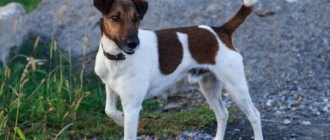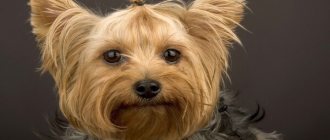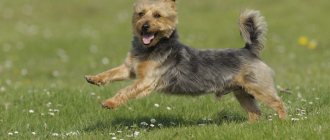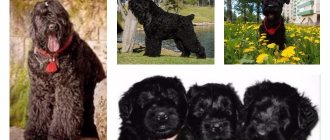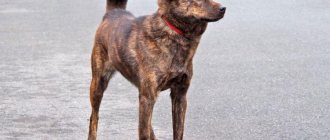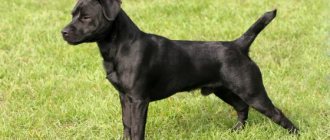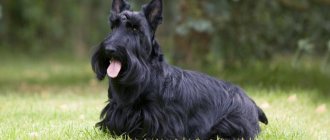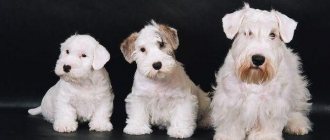/ Dogs / Dog breeds / Lakeland Terrier breed standard, character and care features
0
3257
Article rating
The Lakeland Terrier is an excellent watchdog, a good companion for children and a devoted friend to its owner. Initially, the breed was used when hunting animals living in burrows. This seemingly harmless dog is capable of killing a fox, which cannot be said about most representatives of the terrier breed. But the dog does not pose a danger to people, and will not bark or bite for no reason.
Lakeland Terrier
A little bit of history
This breed is one of the most ancient among all terriers. The first mentions appeared back in 1800. True, at that time the dog had a slightly different name, but after crossing the English Wirehaired Terrier with the Bedlington Terrier, the Lakeland was obtained.
The breed appeared in England for hunting foxes, badgers, etc. The dog could catch up with prey on uneven terrain, in a forest or field, as well as near water. The first exhibition was in 1912, it was then that the first breed standard was adopted. The latest changes to the Lakeland Terrier standard were made in 2009. As noted above, today a dog of this breed is practically not used for hunting; it acts as a companion and participates in exhibitions.
Origin story
At first glance, the Lakeland Terrier looks very similar to the Welsh Terrier, but in fact these two breeds developed independently of each other and are direct evidence of how climatic and geographical conditions, together with climate, influence the appearance and temperament of certain breeds.
The English county of Westmorland is the home of the terrier, named after the Lake District (Lakeland). Sixteen lakes, located in the landscape of the high mountains of England, shaped the character of the Lakeland Terrier. This is an area known for its high and inaccessible hills with a large number of foxes living there. These hills were not called hills, as it should sound in English, but fells, which is why the ancestors of this breed were called Felterrier, Ullswater Terrier or Patterdale Terrier. These dogs have been used for centuries to hunt foxes. Unlike hunting in other parts of England, where the goal was not to kill the fox during the hunt, in the Lake District the dogs had such strong jaws, great courage and ability that they could deal with the fox in no time.
In some parts of England, Lakeland Terriers were used to hunt with hounds, which further developed the Terrier's high speed and long limbs. At the end of the 19th century, a number of agricultural fairs were held in the lake area, where terriers of a wide variety of colors were exhibited: blue, brown, gray, white. Most often they were intended for hunting otters.
The Lakeland Terrier Association was founded in England in 1921, and the English Kennel Club recognized the breed only in 1931, despite the fact that the breeding of purebred dogs of this breed began in 1850. In 1928, this breed was first presented at an exhibition organized by the Kennel Club, in which Lakeland Terriers aroused too much interest.
Appearance of the dog
The Lakeland is a fairly small dog, but nevertheless has a fairly strong build. The shape is somewhat similar to the Welsh Terrier, but is somewhat smaller in size. The dog's ears are V-shaped, usually folded. The nose is black, the muzzle is strong and the head is well balanced and square in shape. The Lakeland's eye color is usually brown, black or brown. We can say that a dog is an ideal hunter, especially when it comes to hard-to-reach places, for example, mountainous areas. The small, square format and sturdy build allow you to move quickly around the terrain. For example, the narrow body allows Lakeland Terriers to squeeze into narrow crevices without any problems. Their fur is quite long and wire-like. There is long decorative hair on the face and limbs. It is by this last parameter that it is possible to distinguish the Lakeland from other terriers. Let's take a closer look at the standard of this breed.
Breed standard
The Lakeland Terrier was bred by humans. When breeding the breed, the goal was to obtain an assistant for hunting burrowing animals. The specialists achieved their goal.
- The dog's body shape is square. This does not mean that its shape is angular. The square format assumes that the dog can be mentally fit into a square. Although, bitches are allowed a rectangular body shape, which should not be too elongated. The build is quite strong. The body is not wide, which allows the Lakeland Terrier to penetrate into holes. In general, representatives of the breed look proportional.
- The head is quite large compared to the body and resembles a rectangle shape, with smoothed ribs. Lakeland Terriers have powerful jaws, which allows them to win in the fight against burrowing animals.
- The ears are set high on the head and have the shape of a triangle. In this case, the ends of the ears are bent forward and touch the head. The fold line of the ear is only a couple of millimeters above the line of the skull.
- On the large muzzle there are small eyes of a dark color and oval shape. The fit is average. The back of the wide nose is straight. The transition from the muzzle to the forehead is weakly expressed. If we talk about proportions, then the length of the muzzle from the nose to the transition point between the forehead and muzzle is equal to the length of the head from the same point to the occipital protuberance. Violation of these proportions is a gross deviation from the standard.
- Representatives of this breed have powerful teeth and a scissor or straight bite.
- The graceful and long neck of medium size goes into a fairly high withers. The skin on the neck does not sag.
- The Lakeland Terrier's limbs are long. This allows the dog to move over rough terrain without any problems. The shoulder blades, which are long compared to the shoulders, are located obliquely in relation to each other. The paws are straight, with well-developed muscles.
- The high-set short and narrow tail “looks” upward. If you look at the dog from the side, placing it sideways towards you, you will notice that the tip of the tail and the occipital protuberance are on the same line. This is especially clearly seen in the photo where you can draw a straight line connecting the tip of the tail and the occipital protuberance.
- When moving, the dog looks graceful and has a long stride.
- The height at the withers does not exceed 37 cm. At the same time, a purebred Lakeland Terrier cannot be significantly shorter. If we are talking about a male, then an error of 1-2 cm is allowed; females can be 2-3 cm smaller. Despite the average height, the dog is light. Its weight, on average, is 7.5-8 kg. This is the norm for dogs whose height is 37 cm. If the height is shorter, then the weight should be correspondingly less.
A violation of the standard is
- too light or coarse body build;
- short limbs, as a result of which the pet looks squat;
- massive body.
Character of Lakeland Terriers
As noted above, currently the dog is exclusively a pet. But the hunting instincts, although dulled, did not disappear. This is why Lakeland Terriers are quite active and do not like to sit in one place for a long time. They are playful and cheerful, but only with their owners. Strangers are treated with some caution and distrust. Most representatives of the breed are excellent guards, so they are often used for these purposes. Again, this all comes down to courage and self-confidence. Lakeland will guard to the last and will never retreat. All terriers are not prone to panic when a threat appears, and the Lakeland especially. Many owners say that they get along well with children and do not show aggression towards them at all. With all this, dogs of this breed are very independent and are not so easy to train. Therefore, if you are planning to teach your companion new commands, be patient and persevering.
Character
The Lakeland Terrier is an inquisitive dog that requires the attention of its owner. He is vigilant and assertive, he knows no fear. Pets have a lot of energy that they need somewhere to put. Therefore, you need to walk a lot with the Lakeland Terrier. At the same time, passive walks will not satisfy your pet. You need to play with your pet and let him run around as much as he can. Representatives of the breed are distinguished by their endurance. They can, if necessary, walk all day.
The Lakeland Terrier loves to be the center of attention. He must be close to the owner. At the same time, do not try to sit your four-legged friend in your arms. He prefers to sit near his owner, rather than in his arms. It is difficult to find a more loyal dog.
Representatives of the breed are good companions for children. But, it is worth mentioning that this dog will never share his toys. Therefore, teach your child that everyone should play exclusively with their own toys. And you should not scold your pet for such behavior. It is laid down by genes.
When it comes to friendship with other animals, the Lakeland Terrier will not be a good companion. This dog does not like cats, and is capable of harming them. And any furry animal is a subject of hunting for her.
The Lakeland Terrier gets along with dogs reluctantly and can be aggressive towards them, especially if we are talking about representatives of the same sex as the pet itself. Therefore, breeders recommend getting such a dog for those people who do not have other pets.
The Lakeland Terrier considers itself part of the family. Therefore, he must be treated almost equally. Nobody says that a dog should be overly pampered, however, there is no need to show your superiority.
About size and color
The interesting thing is that the standard does not imply any specific color, so it can be anything. Among the solid colors, the most common are blue, black, red, wheaten and liver. The saddle cloth should cover the scruff of the neck and back. Moreover, it can have a blue, black or wheaten color, covered with gray hair. Other parts of the body, such as the head, limbs, shoulders, are found in golden wheaten, yellowish or brown color. All these colors are often mixed, which looks quite interesting.
You already know a little about such an interesting breed as the Lakeland Terrier. The colors, as you can see, come in a wide variety, but the sizes in the standard are described quite strictly. The ideal height at the withers is 37 cm. In this case, a deviation of only 1 centimeter is allowed in both one and the other direction. Males are usually 2.5-3.0 cm taller than females. The ideal weight for a show male with a balanced build is 7.7 kilograms. Experts point out that the individual must be well-balanced and have strong bones.
Dog care
The dog needs daily brushing. It is advisable to trim the Lakeland 2-3 times a year. Excess hair between the fingertips also needs to be removed. Ears should be cleaned as they become dirty, and nails should also be trimmed if necessary.
Important! This dog is most suitable for people with an active lifestyle. She needs quality and long walks. For those dogs that live in an apartment, daily exercise and training in the fresh air are necessary.
On average, the Lakeland Terrier lives from 12 to 16 years . They are prone to certain diseases, namely: lens luxation, distichiasis, Legg-Perthes disease and others. It is worth paying frequent attention to the condition of your dog's eyes and, whenever possible, having him examined by a veterinarian.
Lakeland head appearance
The expression in a dog's eyes changes depending on his mood. In the normal state, the look is wary, but can be cheerful. The eyes are oval-shaped, rather small and widely set. Usually the color of the eyes depends on the coat. For example, liver-colored individuals have dark hazel or brown eyes. In dogs of other colors, the color varies over a wide range. The ears are usually small and resemble an equilateral triangle. They are folded not in the center, but closer to the base of the skull. The transition from forehead to muzzle is practically invisible. The Lakeland's head is quite strong and powerful. Experts usually pay special attention to the proportions of the head, since this is how the selection value of the breed is indicated. Disadvantages include: brown nose, wedge-shaped head, long or short muzzle, etc.
Coat, neck and body
The dog's neck is long and dry, but at the same time quite strong and has no dewlap. The dog's body is short and strong, as well as narrow. The chest is deep and extends to the elbows. The ribs are quite elastic and convex in the area of the spine. The standard has requirements that relate to the tail. They are not mandatory, but indicate the high value of the dog. They consist in the fact that the tail should be raised and slightly curled forward during movement.
The guard hair of the Lakeland Terrier is quite hard and wiry, but the undercoat is very soft and tightly adjacent to the body. However, it should not be thicker than the guard hair. Many people pluck the dog's fur by hand to emphasize the silhouette of the dog. In general, many dog breeders trim their pets in a way that is convenient for them, but show specimens are standardized regarding the length of hair on different parts of the body.
Maintenance and care
You can safely own a Lakeland Terrier both in urban and rural areas. You just have to remember that the dog should under no circumstances be exposed to hypothermia. Therefore, create conditions for your pet so that its place is warm.
In addition, the Lakeland Terrier breed is a hunting breed and needs constant physical activity. In an urban atmosphere, find a large square or park, preferably with a pond, to take your dog for daily walks.
The Lakeland Terrier's coat does not require any complex care. The dog should be trimmed once a quarter. You can brush your pet once a week to remove excess hair. The Lakeland Terrier is practically non-shedding, so you don’t have to worry about a lot of fur in your home.
Pay attention to the dog's ears and eyes, keep them clean. Claws also require regular adjustments.
Lakeland Terrier: owner reviews
It's hard to find a dissatisfied Lakeland owner. Everyone says that this is a very active dog. That is why with such a friend you can easily go for a morning jog, fishing, hunting, or just for a walk. If the dog is healthy, then he is always in a good mood, although a lot depends on how the owner feels. All Lackland Terriers get along with children without any problems, and they enjoy playing with little ones a little or serving as a plush toy for some time. It is also worth remembering that sometimes dogs exhibit instincts. For example, if your terrier is interested in something on the street, then most likely he will chase it, so it makes sense to keep him on a leash. The owners also note that, despite his good intelligence and ingenuity, the dog is difficult to train. He will not carry out monotonous commands according to strict orders; it is better to organize the training in the form of some kind of game and preferably with incentive prizes. Dog breeders recommend training in a consistent manner and not being too harsh or strict.
Care and health
Although the dog has quite long hair, caring for the Lakeland is quite simple, and even a beginner can handle this simple task. Typically, trimming is required several times a year. Particular attention should be paid to the fur on the paws, which grows too long; it needs to be trimmed regularly. Despite the fact that the Lakeland Terrier, whose breed description we have already reviewed, practically does not shed, it must be brushed regularly. Whether or not to trim your friend is up to you. If you plan to use it at exhibitions, then this is a mandatory procedure; if not, then you can limit yourself to trimming.
As for health, the dog is considered to be quite strong and has a stable immune system. However, cases of dysplasia of the hip and elbow joints are common. Such individuals are immediately discarded and not used for breeding purposes. Otherwise, like other purebred dogs, it is necessary to have timely vaccinations, then Lakeland Terrier puppies will grow up healthy.
Rock analysis
Advantages of the breed
- Sociability and friendliness - they become true friends for their owners.
- The intuition of this dog breed is very well developed. They acutely feel what a person really feels towards you and with their behavior they let you know if it is something bad.
Good security qualities of Lakelands. They become excellent protectors of the home and all family members.
- They have a high level of intelligence.
- Their undoubted advantage is that they hardly shed and therefore do not cause allergic reactions. This is a very important point for allergy sufferers.
Disadvantages of the breed
- They need a lot of attention from their owner - without it they can grow up to be cowards and show aggression for no reason.
There are cases of aggression without any particular reason. They can very quickly go on the offensive if they simply don’t like someone.
- They bark a lot, which is a problem, especially for those who live in apartments, which means next to neighbors.
- Unfriendliness with other pets.
Raising a Lakeland Terrier puppy is quite a difficult task, but once you raise a dog, you will be more than rewarded for your efforts. To do this, it is necessary to carefully train this breed of dog, otherwise it will grow into an uncontrollable animal.
About the habitat
This breed feels good in the wild, but after taming by humans, many individuals became completely tame. However, you can keep a terrier outside. True, for this you should take care of the dog’s place of residence. But the Lakeland Terrier also feels good in the apartment. Photos of individuals used for selective selection can be found in this article. Exhibition specimens cannot be kept outside all year round, especially in low temperatures and poor conditions. This is due to a large number of reasons. The dog's character, coat quality, and much more change.
Character and temperament
The breed, despite its not too large size, has incredible courage, courage and fearlessness. The Lakeland Terrier is an excellent hunter. He can easily drive a wild animal into a hole and rush at it. In addition, the dog has an extremely sensitive nose, which allows it to accurately pick up the scent of an animal and lead the owner to it. In the family circle, the dog is kind, affectionate and reliable. Distrustful of strangers, so can be a vigilant watchman.
See also: Beauceron breed
